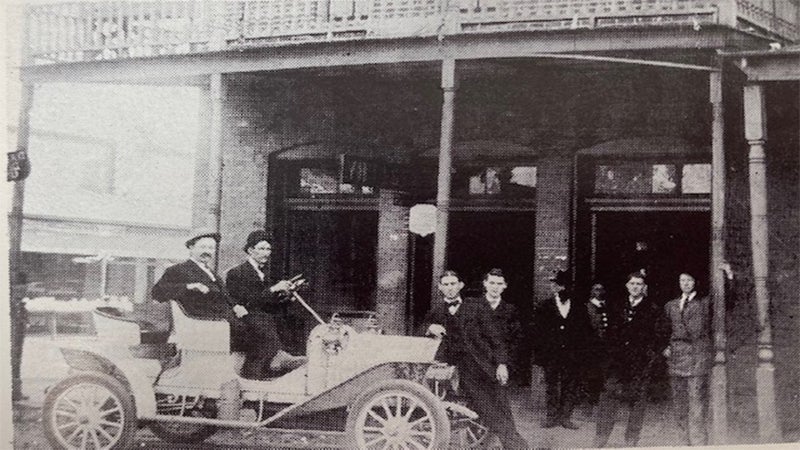COLUMN: Remember When: Thinking back to yesteryear
Published 2:45 pm Friday, January 12, 2024

- An early 1900s downtown Andalusia scene. (PHOTO PROVIDED)
|
Getting your Trinity Audio player ready...
|
Most Andalusia citizens don’t realize they are interested in the history of Covington County until the topic comes up in conversation. All of a sudden, they enjoy hearing about the first train that steamed into town and blew its whistle or the first movie house that was located in the Prestwood Building around 1910. Maybe when the first drug store on Court Square owned by J. D. McPherson being operated in a wooden structure is visualized and sited as an important part of the downtown business establishment. Hmm, we start thinking about that early location now the Hester Law Firm office.
Were boardwalks and hitching posts really located all around the unpaved square with a courthouse in the center? It was said that the decent ladies had to be careful not to get mud on their frocks, and they were often escorted to avoid the inebriated persons on the street who had just left the barrooms.
Were saloons really prominent on the Court Square? Were ladies invited to promenade to the Millinery Department of the Dry Goods business to see the latest fashions and styles? Can you imagine shopping for bacon, lard, flour, sugar, and coffee in the same Dry Goods store?
Picture this – only four brick stores in the town around 1901, the Sentell, Milligan, Henderson, and Shreve buildings. Factual and interesting is the story about the original forty acres of land where Andalusia was to be located. This parcel was conveyed to the county on June 1, 1845 according to Gus and Ruby Bryan, authors of Covington County History 1821-1976. Yes, there were early disagreements of exactly where the courthouse should be located – River Falls or a settlement known as Silver Springs, a few miles south of Andalusia. The majority favored “Newsite,” a public poll revealed. Historians are still trying to figure out how Andalusia got its name.
Did the local newspaper, The Covington Times, in the late 1880’s, edited by W. P. Howell, advertise the motto of the Tillis and O’Neal store on the square, “Live and Let Live?” Old accounts of Rev. E. E. Cowan record that the post office was moved from Montezuma to the Charles G. Lynch store on July 18, 1844. Lynch was the first man to run a store up the hill from the river town Montezuma plagued by mosquitoes and fever in the wake of the little wilderness town more or less washed away by the “Harrison Freshet.”
Were ordinary businesses that operated in downtown Andalusia remembered as being livery stable, blacksmith shop, mercantile/dry goods store, drug store, saloon, doctor’s office, church, newspaper office, hotel and boarding house, shoe shop, jailhouse, post office, and lawyer’s office? According to a map drawn by L. F. Adams which he titled, “ANDALUSIA as it appeared about the year 1889,” Andalusia was described as the county seat of Covington County, located just east of the Conecuh River, on a high hill that overlooks the surrounding country, the watershed divide of the Conecuh and the Yellow River waters. One old timer said, “Stand on the steps of the courthouse. One can spit to the right and you will hit the Conecuh River. Spit to the left and you hit the Yellow River.” That was, of course, after the present county courthouse was completed in 1917.
Can you picture the rows of chinaberry trees bordering the edges of the public square? “Under those trees the children played in the daytime, and men rested their oxen in the shade of them. At night the cows and wild hogs would gather from the surrounding forests to stay the night under their sheltering boughs.” Editor Howell penned these words.
As you ride down East Three Notch Street today, can you picture the unpaved streets with wagon ruts several inches deep? No wonder the main streets got paved in the early 1920’s to accommodate the new horseless carriages. Horse and buggies along with mules and wagons still transported people for many years to come.
Much has been talked about regarding one of the most colorful parts of Andalusia’s past, the large three-story building on South Three Notch Street, the social and entertainment center for the area in the early 1900’s. Known as the McArtan Opera House, which engaged operas and traveling shows for the general public, it was built by McArtan and McRainey who also helped to organize one of Andalusia’s first banks, the Andalusia Bank and Trust which merged with the Bank of Andalusia. Piano recitals and even school graduations were held in the Opera House prior to the construction of the East Three Notch School Auditorium. Andalusia’s interest in the arts including musical and dramatic entertainment goes back way over 100 years ago.
It is remembered that fire fighting efforts were probably on a volunteer basis but city clerk’s records state that as early as 1904, steps were taken to purchase fire fighting equipment. In 1905 a fire whistle was installed for the town. In 1912 Lon Gillis was appointed Captain of the Fire Department.
Police department history dates from 1884 when a Marshall was appointed at a salary of $12.50 per month. The duty of the marshalls was to keep the streets in repair and collect the taxes. Many names of early citizens who served in these capacities are listed in the city records.
B. H. Lewis was elected the first mayor in 1884. So we can only imagine what went on from 1844 when the settlers moved up the hill from Montezuma to 1884 when the little village became more populated and organized.
County affairs ran a little more smoothly under a new judicial system when the first Probate Judge of Covington County, William T. Acree, was elected by popular vote of the people in 1850. George Snowden, his assistant, succeeded him in 1854. Other names in leadership include Thomas Cottle, 3rd Probate Judge, A. J. Fletcher, 4th Probate Judge, Malachi Riley, 5th Probate Judge, and J. M. Robinson who served continuously for 28 years. Did you ever wonder where Robinson Memorial Park got its name?
Well, In case you don’t know what some of the most popular forms of social gatherings was in those old days, let me mention the log rollings and the barn raisings. My grandfather once asked my sister who was all dressed up and made up with eye shadow, “Sally, have you been to a log rolling?” Born in the mid 1890’s, Dad Brunson had definitely been to a log rolling! There was probably some fiddlin’ and pickin’ and square dancin’ going on at the same time – maybe even a turkey shoot or a rooster fight. We’ll talk about some more history soon in another Remember When column.
Sue Bass Wilson, AHS Class of 1965, a local real estate broker, is a former choral music teacher and long time member of the Covington Historical Society. She can be reached at suebwilson47@gmail.com.




